Several key indicators can reveal underground pipe leaks beneath flooring. Warning signs include unexplained water pressure drops below 40 PSI, monthly usage exceeding 12,000 gallons, and visible surface changes like warped hardwood or loose tiles. Homeowners should monitor for musty odors, dampness, or continuous hissing sounds during quiet nighttime hours. Professional plumbers utilize specialized acoustic equipment and thermal imaging tools to precisely locate concealed leaks before extensive damage occurs. Further investigation reveals additional detection methods and prevention strategies.
Key Takeaways
- Listen for continuous hissing or whooshing sounds when the house is quiet, particularly during nighttime hours.
- Check floors for visible damage like warped hardwood, loose tiles, damp carpet spots, or cracks in concrete.
- Monitor unexplained increases in water bills, especially if monthly usage exceeds 12,000 gallons or shows 50% increase.
- Look for water-loving insects, musty odors, or mold growth near floor areas.
- Watch for wet spots, pooling water, or unusually saturated areas in your lawn near the building's foundation.
Common Warning Signs of Underground Pipe Leaks
When homeowners suspect underground pipe leaks, multiple warning signs can manifest both inside and outside the property. Effective leak detection techniques involve monitoring both internal and external indicators.
Inside the home, signs include reduced water pressure during appliance usage, unusual pipe noises, and the presence of dampness accompanied by musty odors. A family using over 12,000 gallons monthly likely indicates a significant leak requiring immediate attention. Water-loving insects and unexplained mold growth also indicate underground plumbing issues.
External manifestations present as saturated lawn areas, unexpected vegetation growth patterns, and the formation of sinkholes or potholes. Property damage may include foundation cracks, compromised wall integrity, and deteriorating flooring.
Technical indicators comprise running water sounds when fixtures are inactive, meter fluctuations during non-use periods, and the presence of sediment or air in the water supply. Hissing sounds and pressure variations further confirm potential underground pipe failures.
Understanding Water Bill Changes and Usage Patterns

Understanding water bill fluctuations requires systematic analysis of consumption patterns and meter data to identify potential underground pipe leaks.
Property owners should monitor their monthly water usage trends, factoring in seasonal fluctuations that typically show higher consumption during summer months and lower usage in winter. Unexplained increases of 50% or more may indicate subsurface plumbing issues. The average American household wastes approximately 180 gallons per week from various types of leaks.
To verify meter accuracy, residents should conduct periodic tests by recording meter readings before and after filling containers of known volume. If the meter dial spins when all water fixtures are inactive, this indicates potential leakage.
Analyzing year-over-year usage data from utility bills, particularly during similar seasonal periods, helps differentiate between normal variance and leak-related consumption spikes. Community comparison metrics provided by utilities can further validate whether increased usage patterns are localized to the property.
Visual Indicators on Different Floor Types
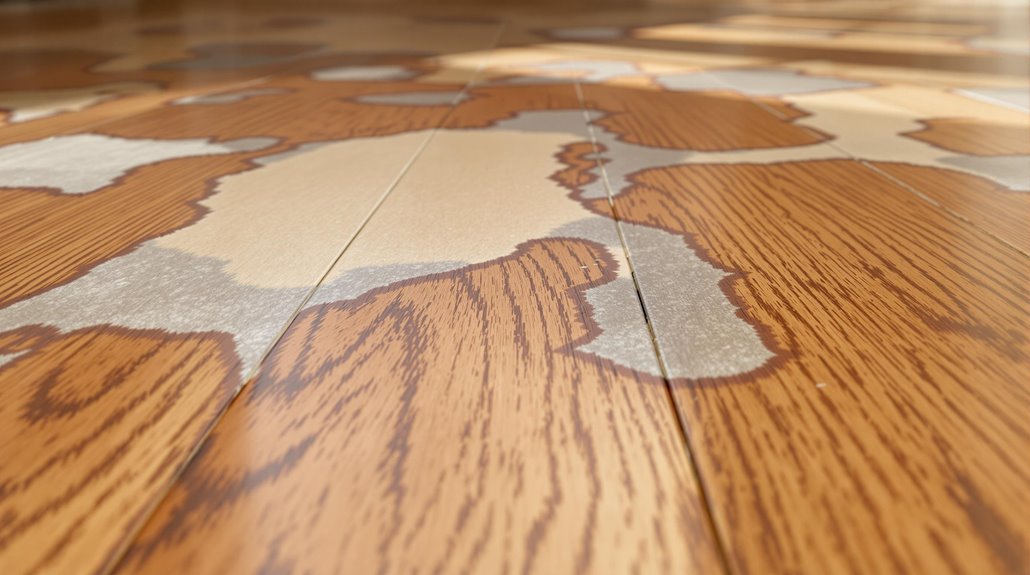
Identifying pipe leaks beneath flooring requires careful inspection of surface-level indicators across different flooring materials. During floor inspection, professionals evaluate specific moisture detection signs unique to each flooring type. Professional leak detection specialists are essential for thorough assessment since they have specialized equipment and expertise.
| Floor Type | Primary Indicators | Secondary Indicators |
|---|---|---|
| Hardwood | Warped boards, discoloration | Musty odors, cracks |
| Tile | Grout deterioration, loose tiles | Water stains, mold |
| Carpet | Damp spots, odors | Subfloor warping |
| Concrete | Surface cracks, pooling | Erosion, staining |
Each flooring material exhibits distinct warning signs of underlying pipe leaks. Hardwood displays warping and darkening, while tile shows grout deterioration and loosening. Carpeted areas reveal dampness and musty odors, whereas concrete develops cracks and visible moisture accumulation. Professional assessment of these indicators enables early leak detection and minimizes structural damage.
Detecting Unusual Sounds and Water Movement
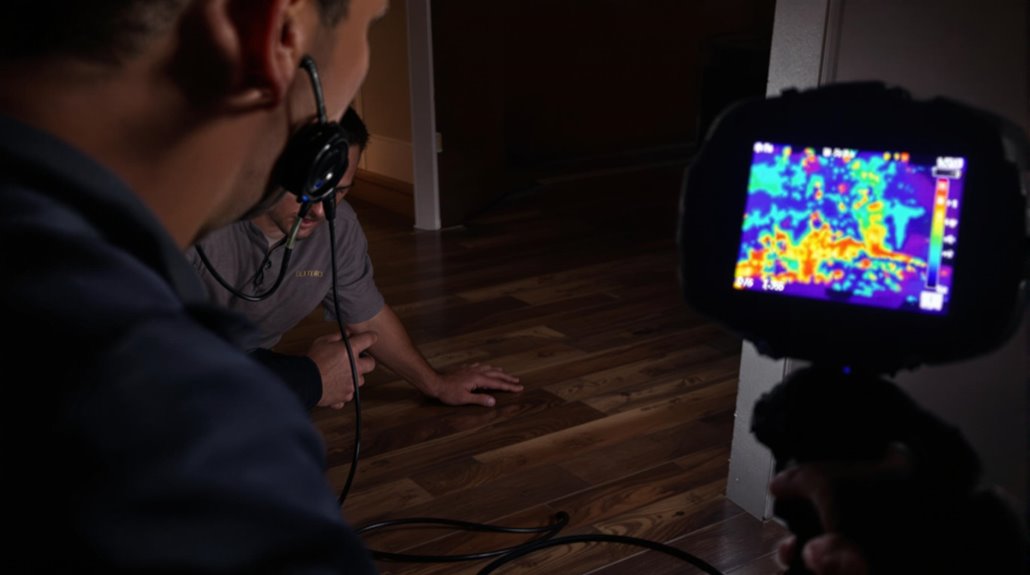
Beyond visible indicators, acoustic monitoring serves as a reliable method for detecting underground pipe leaks. Unusual sound detection techniques involve identifying continuous low hissing or whooshing noises, which typically indicate pressurized water escaping from compromised pipes.
Professional leak identification techniques often employ specialized equipment such as acoustic stethoscopes to amplify and trace water movement sounds. For ideal detection accuracy, monitoring should occur during nighttime hours when ambient noise is minimal.
Systematic isolation of water supply sections helps pinpoint precise leak locations. However, practitioners must differentiate between genuine leak indicators and common misinterpretations, such as water hammer effects or thermal expansion sounds in copper pipes.
Professional assessment utilizing advanced detection tools, including thermal imaging cameras, is recommended for conclusive diagnosis of subsurface plumbing issues, particularly in complex under-floor scenarios.
Identifying Moisture and Mold Problems
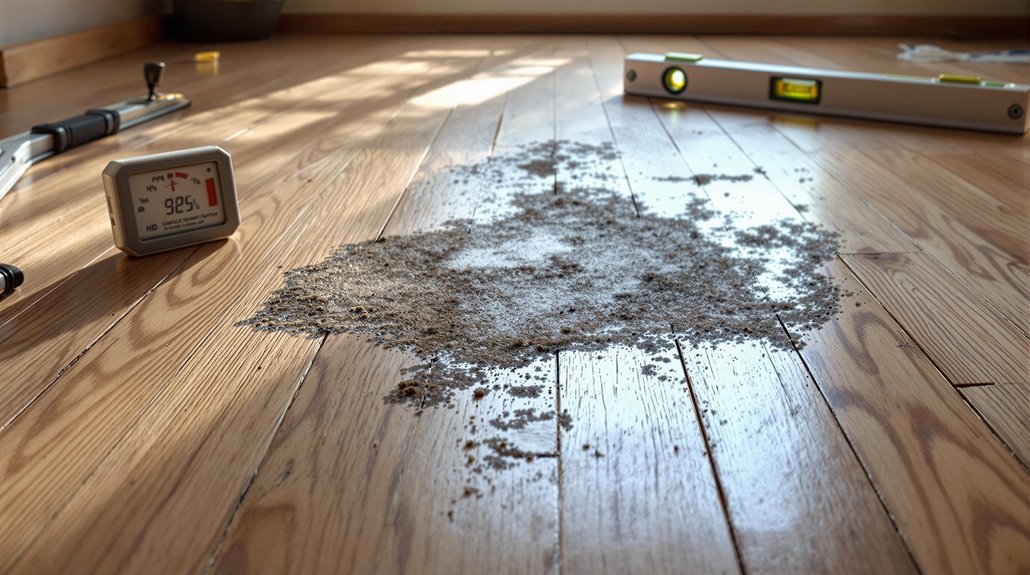
Moisture intrusion beneath flooring manifests through distinct physical and environmental indicators that signal potential pipe leakage. Professional moisture detection methods include monitoring structural deformation, surface discoloration, and environmental changes. Advanced mold identification techniques focus on visual inspection and air quality assessment.
| Indicator Type | Primary Signs | Detection Method |
|---|---|---|
| Visual Changes | Warping, Cupping | Surface Inspection |
| Environmental | Musty Odors, Humidity | Hygrometer Reading |
| Structural | Floor Settlement | Level Assessment |
| Secondary Signs | Water Bill Increases | Usage Analysis |
Regular inspection protocols should include examining grout lines, corners, and subflooring areas where moisture accumulates. Technical assessment must focus on identifying dark patches, monitoring relative humidity levels, and evaluating floor integrity. When conducting moisture evaluations, professionals should document all instances of surface degradation, paying particular attention to areas exhibiting spongy texture or visible mold growth.
Using Professional Leak Detection Tools
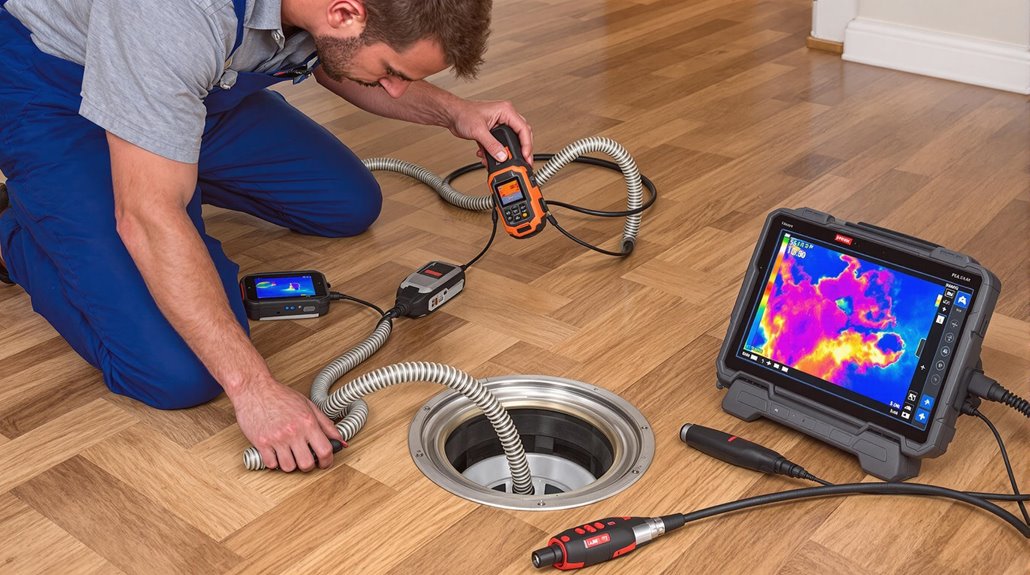
Professional plumbers employ three primary categories of leak detection equipment to locate sub-floor pipe issues:
acoustic devices that detect sound frequencies between 10-50,000 Hz to identify water movement, high-resolution video inspection cameras with 50-foot flexible probes for direct visual confirmation, and infrared thermal imaging tools capable of detecting temperature variations of 0.05°C.
These specialized tools enable technicians to pinpoint leak locations with 98% accuracy while minimizing the need for destructive investigation methods.
The combined use of acoustic sensors, video systems, and thermal cameras creates a thorough diagnostic approach that meets industry safety standards and regulatory requirements for residential and commercial plumbing inspections.
Acoustic Leak Detection Equipment
Modern acoustic leak detection equipment employs advanced signal processing technology and specialized sensors to identify water leaks beneath flooring with precision. The acoustic sensors can detect leaks up to 8 meters deep, functioning effectively across various pipe materials including PVC, steel, and cast iron.
These sophisticated devices utilize noise-canceling technology and high-sensitivity sensors to isolate leak sounds from background interference. The equipment operates by analyzing sound intensities at different points, with intelligent displays providing real-time data visualization.
Detection capabilities begin at pressures as low as 2 bars, making it effective for identifying even minor leaks. The system's multi-sensor compatibility allows for thorough analysis across different environmental conditions, while material-specific considerations guarantee accurate sound transmission interpretation through various floor compositions and soil conditions.
Video Inspection Camera Systems
Video inspection camera systems represent a sophisticated diagnostic tool that enables precise underground pipe examination through high-resolution imaging technology.
These systems utilize flexible snakes equipped with cameras capable of traversing pipes as small as 1-1/2 inches in diameter, providing real-time monitoring and recordable footage for documentation.
Key pipe inspection benefits include:
- Immediate identification of leak locations without extensive excavation
- Prevention of costly structural damage through minimal invasive diagnostics
- Enhanced accuracy in problem detection through direct visual confirmation
- Significant time savings compared to traditional inspection methods
- Documentation capabilities for future reference and repair planning
Professional video camera features include built-in depth measurement, sonde heads for precise underground detection, and durable construction suitable for challenging environments.
When operated by trained technicians, these systems can efficiently diagnose issues while minimizing property disruption.
Thermal Imaging Detection Tools
While video inspection offers direct visual confirmation of leaks, thermal imaging detection tools provide a sophisticated non-invasive approach to identifying subsurface pipe issues through temperature differential analysis.
The thermal camera benefits include detecting temperature anomalies caused by water leaks without destructive testing. Professional-grade cameras with high thermal sensitivity offer superior detection capabilities during sunrise or sunset inspections.
Infrared thermography applications require strategic methodology for accurate results. Technicians run hot water through pipes for 15-30 minutes before scanning, ensuring temperature contrasts are visible.
High-resolution cameras with adjustable level settings, such as FLIR E8/E95 models, enable detection of subtle variations. This technology proves particularly effective when combined with moisture meters for verification, making it an essential tool for both residential and commercial plumbing diagnostics.
The Role of Water Pressure Testing
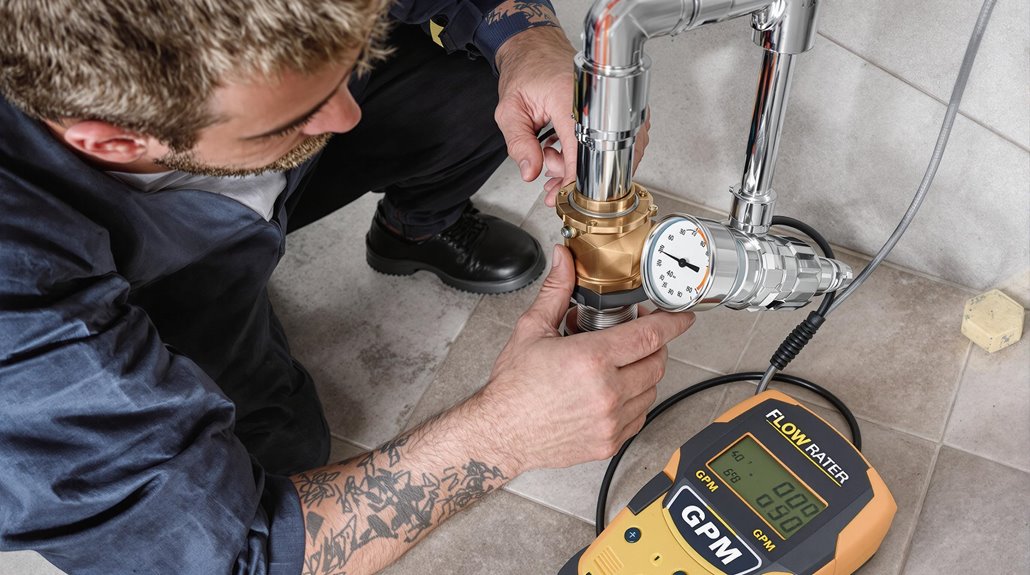
Professional plumbers utilize calibrated pressure gauges to monitor water pressure levels, typically maintaining readings between 40-80 PSI for residential systems.
Flow rate testing equipment measures water movement through pipes in gallons per minute (GPM), with sudden variations indicating potential underground leaks.
These diagnostic methods, when used in conjunction with hydrostatic pressure testing, provide measurable data points to accurately identify subsurface pipe failures while maintaining safety protocols.
Pressure Gauge Reading Methods
Accurate pressure gauge readings provide essential diagnostic information when testing for underground pipe leaks. Using properly calibrated pressure gauges, technicians monitor system pressures at 80-100 PSI for a minimum 15-minute duration.
These leak detection techniques rely on precise measurements to identify potential breaches in underground plumbing systems.
- Loss of system pressure indicates active leaks requiring immediate attention
- Stable readings confirm structural integrity of pipes
- Sudden pressure drops suggest significant pipe failures
- Gradual pressure decline points to minor leaks or seepage
- Zero pressure loss verifies watertight connections
Professional pressure testing requires proper gauge installation using plumber's tape at accessible points like faucets or shower valves.
Hydrostatic testing, preferred for underground systems, offers superior accuracy compared to pneumatic methods when identifying subsurface leaks through pressure differentials.
Water Flow Rate Testing
Proper water flow rate testing combines volumetric measurements with pressure analysis to detect underground pipe leaks effectively. Modern leak prevention strategies integrate flow meters with pressure testing systems, operating at 80-100 PSI, to provide thorough monitoring capabilities. Water conservation techniques benefit from real-time flow analysis against predetermined thresholds.
| Testing Method | Detection Range | Application |
|---|---|---|
| Flow Monitoring | 0-100 GPM | Real-time Usage |
| Pressure Testing | 80-100 PSI | System Integrity |
| Acoustic Detection | 1-5kHz | Leak Location |
| Hydrostatic Test | 150% Operating Pressure | Main Lines |
When flow rates exceed normal parameters, automatic shutoff valves activate to prevent water damage. Integration with Building Management Systems enables immediate alert notifications, while continuous monitoring guarantees early leak detection and maintains system efficiency. This thorough approach maximizes detection accuracy while minimizing potential water loss.
Structural Impact and Foundation Concerns
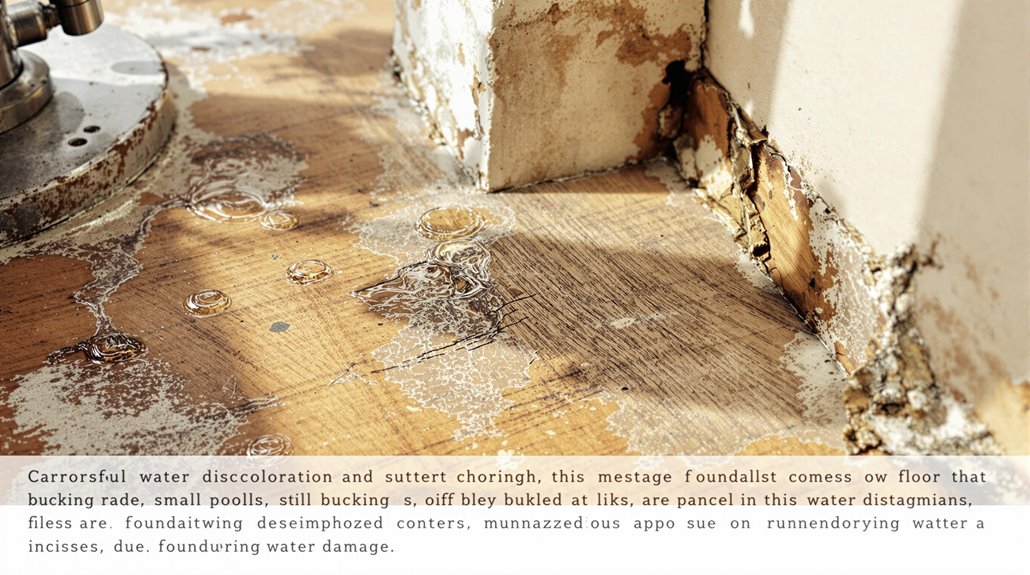
Underground water leaks can severely compromise a building's structural integrity and foundation stability through multiple degradation pathways. The persistent infiltration of water from leaking pipes leads to foundation instability through soil erosion and displacement.
Effective moisture management becomes critical as water saturation causes expansion and contraction cycles in surrounding soil structures.
Key structural concerns include:
- Compromised load-bearing capacity of steel framework due to oxidation
- Progressive deterioration of concrete reinforcement systems
- Settlement-induced stress on foundation walls and footings
- Accelerated degradation of supporting beams and columns
- Risk of catastrophic foundation failure without intervention
Professional assessment becomes essential when these conditions emerge, as structural damage can progress rapidly once initiated.
Early detection through systematic inspection protocols helps prevent extensive foundation compromise and guarantees timely remediation of underlying moisture sources.
Essential Steps for Early Leak Detection

Regular monitoring of water meters provides quantifiable data to detect underground pipe leaks, with readings taken at 2-hour intervals during periods of zero water usage.
Systematic acoustic monitoring can identify water flow sounds between 20-60kHz, indicating potential subsurface leakage points beneath flooring materials.
Professional-grade ultrasonic leak detectors should be utilized to measure sound intensity levels above 7 decibels, which typically signal active water escape from compromised piping systems.
Monitor Your Water Meter
One of the most reliable methods for detecting underground plumbing leaks involves systematic monitoring of the water meter’s indicators. The meter, typically located near the curb in a concrete box, features six dials: four white dials measuring hundreds of cubic feet and two black dials specifically for leak detection. A colored triangle or asterisk serves as the primary leak indicator. By regularly checking the water meter’s indicators, homeowners can identify any unusual movements that may signify a leak in the system. This is particularly crucial for detecting water leaks under slabs, as undetected leaks can lead to significant property damage and costly repairs. If the colored triangle continues to move, it indicates that water is flowing even when all fixtures are turned off, warranting further investigation to pinpoint the source of the problem.
- Check the leak detector while all water fixtures are off
- Observe the colored indicator for several minutes
- Document any movement in the indicator when water isn't in use
- Turn off the main house valve to isolate leak location
- Monitor water bills for unexplained increases
For accurate leak detection, guarantee proper access to the meter box using a screwdriver.
If the indicator moves without active water usage, this confirms the presence of a leak requiring immediate investigation.
Listen For Running Water
When investigating potential pipe leaks beneath flooring, careful auditory monitoring serves as a critical diagnostic method for early leak detection. Technicians employ systematic sound analysis techniques to identify characteristic indicators of water escape. The process involves listening for continuous dripping or running water sounds that persist without an apparent source or regular pattern.
For precise leak detection, professionals evaluate volume variations while moving methodically around the suspected area. Changes in sound intensity often correlate with proximity to the leak source. Specialized equipment, such as sonoscopes, can amplify and isolate water-related sounds through the flooring material.
This acoustic investigation should focus particularly on areas exhibiting additional warning signs, including unusual cold spots, musty odors, or visible discoloration. If persistent water sounds are detected, immediate professional inspection is recommended to prevent structural damage.
When to Call a Professional Plumber
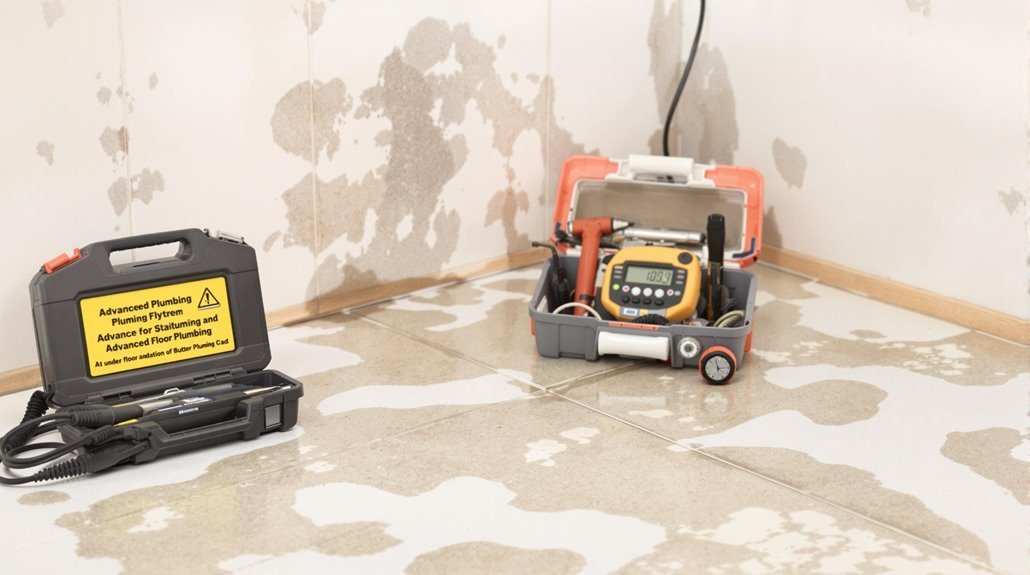
Professional plumbing expertise becomes essential when homeowners encounter specific warning signs of under-floor pipe leaks that exceed DIY capabilities. Key pipe leak symptoms include unusual water meter readings, persistent moisture issues, and foundation concerns requiring advanced diagnostic equipment.
Critical plumbing maintenance tips indicate professional intervention when:
- Slab foundation leaks manifest through visible floor damage or persistent dampness
- Water meter continues spinning despite all fixtures being off
- Multiple floors show water stains, indicating systemic plumbing failure
- Sewage odors persist, suggesting compromised underground pipes
- Foundation shows signs of settling or uneven surfaces
For safety and structural integrity, licensed plumbers must address complex under-floor leaks using specialized leak detection systems and repair protocols, particularly when dealing with sewer lines or main water supply connections.
The Benefits Of Consulting A Public Adjuster
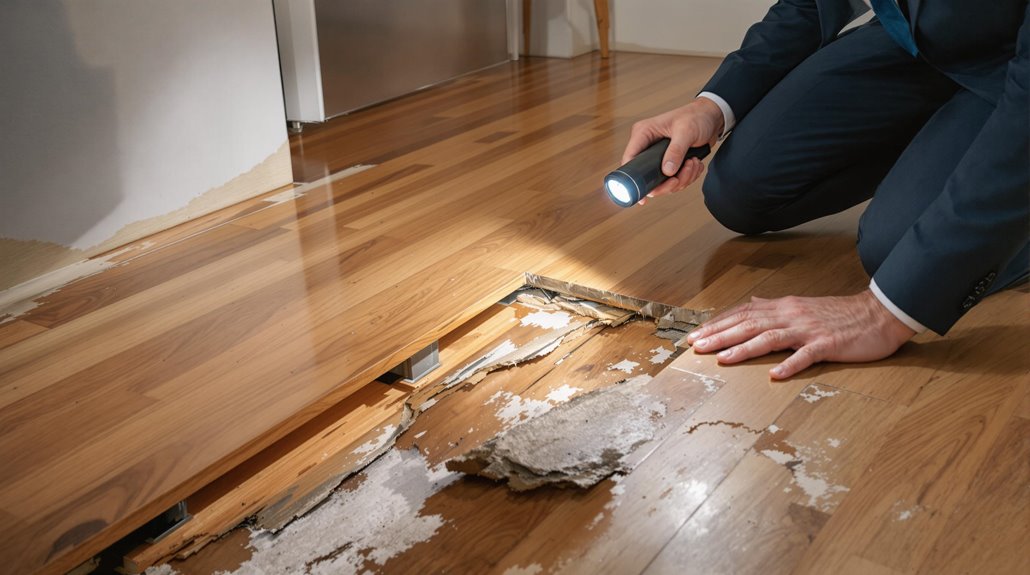
When dealing with water damage from leaking pipes under flooring, consulting a licensed public adjuster can provide expert guidance through complex insurance claims processes and guarantee extensive documentation of all damages.
Public adjusters conduct thorough, objective assessments of water-related structural damage, often identifying issues that might be overlooked during standard insurance inspections.
Statistical data indicates that claims handled by public adjusters typically result in settlements 40-700% higher than self-negotiated claims, while simultaneously reducing the policyholder's time investment and stress levels throughout the documentation and negotiation phases.
The 10 to 20 percent fee structure for public adjusters is typically offset by significantly higher settlement amounts and professional claim management services.
Expertise In Insurance Claims
Due to the complex nature of water damage insurance claims, consulting a licensed public adjuster can greatly enhance claim outcomes and settlement values.
Through strategic insurance claim strategies and dedicated policyholder advocacy, these professionals navigate intricate policy terms while ensuring thorough documentation of water-related damages. Their expertise encompasses detailed damage assessment protocols and extensive understanding of coverage parameters.
- Systematic evaluation of water damage extent using moisture detection equipment
- Professional documentation of affected structural components and materials
- Strategic compilation of repair cost estimates and supporting evidence
- Thorough analysis of policy coverage limitations and exclusions
- Implementation of documented water mitigation protocols for claim validation
Public adjusters utilize technical expertise to interpret policy provisions, evaluate damage scope, and negotiate settlements.
Their systematic approach incorporates industry-standard procedures, ensuring all eligible damages are properly documented and claimed within policy parameters.
With settlement success rates consistently higher than self-managed claims, public adjusters typically secure more favorable compensation for water damage repairs.
Objective Damage Assessment
Accurate damage assessment through objective analysis forms the cornerstone of successful insurance claims processing. When dealing with under-floor pipe leaks, professional leak detection and thorough damage evaluation are essential components of the assessment process. A qualified public adjuster utilizes advanced documentation methods and specialized expertise to guarantee complete evaluation of all affected areas. Independent claims adjusters can provide additional advocacy for complex water damage cases that require extensive documentation and negotiation.
| Assessment Component | Technical Parameters |
|---|---|
| Moisture Detection | 12-48% relative humidity range |
| Structural Analysis | Load-bearing capacity evaluation |
| Material Degradation | pH testing, microbial assessment |
The assessment protocol requires systematic documentation of visible and concealed damages, including photographic evidence, moisture mapping, and thermal imaging. This data-driven approach enables accurate quantification of damages while guaranteeing compliance with insurance policy requirements and building codes, ultimately facilitating fair claim settlements.
Streamlined Claim Process
A streamlined insurance claims process greatly enhances the efficiency and accuracy of water damage assessments through systematic protocols and digital automation.
Modern insurance technology integrates AI-driven solutions and automated validation systems to expedite claims processing while maintaining precision in documentation.
- Experience reduced processing times through automated document generation
- Gain expert guidance from public adjusters who navigate complex policies
- Access real-time claim status updates via digital portals
- Receive exhaustive damage evaluations guaranteeing maximum recovery
- Benefit from professional negotiation with insurance providers
The implementation of electronic claims filing and automated workflows enables adjusters to process claims with enhanced accuracy.
This technological integration, combined with the expertise of public adjusters, guarantees thorough documentation of water damage while minimizing potential delays in the assessment and settlement process.
Working with public adjusters who charge contingency fees only helps homeowners avoid unexpected upfront costs while pursuing their water damage claims.
Higher Claim Payouts & Settlements
Professional consultation with a public adjuster greatly increases the likelihood of securing ideal insurance settlements for water damage claims.
Through extensive claim valuation procedures, these specialists conduct thorough assessments of under-floor pipe leakage, identifying both visible and concealed damage that may impact structural integrity.
Public adjusters excel in detailed damage documentation, cataloging all affected components including subflooring, joists, and adjacent building materials.
Their expertise in policy interpretation guarantees maximum coverage utilization, while their understanding of industry-standard repair costs supports accurate damage estimates.
Operating on a contingency basis, these professionals leverage their negotiation skills and knowledge of insurance procedures to secure settlements that adequately address all documented damages, potentially resulting in markedly higher compensation compared to self-managed claims.
Unlike insurance adjusters who represent carriers, public adjusters charge up to 10 percent of the final settlement amount while working solely in the policyholder's best interest.
About The Public Claims Adjusters Network (PCAN)
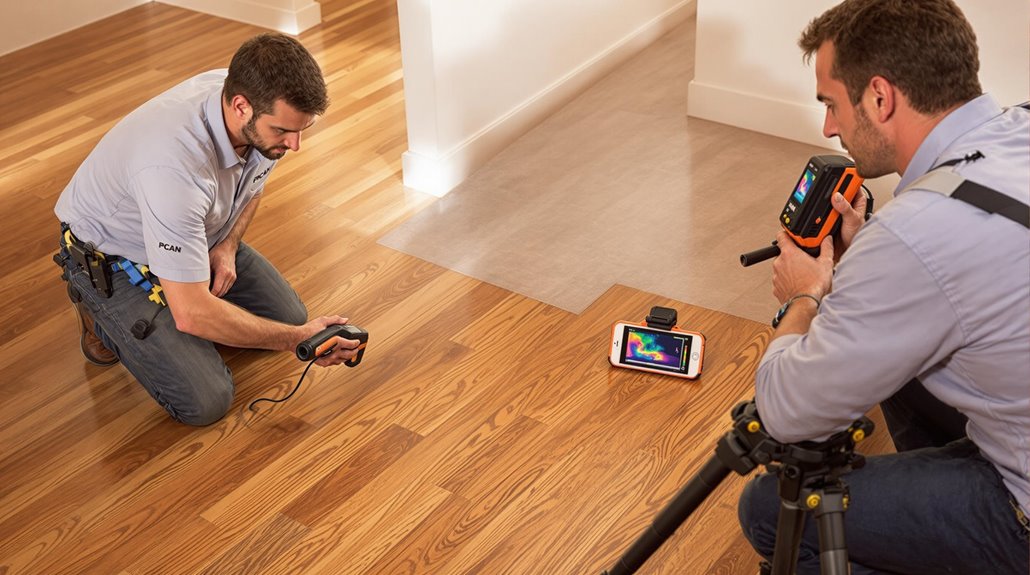
The Public Claims Adjusters Network (PCAN) operates as a thorough alliance of licensed insurance claim specialists who facilitate policyholder advocacy during property damage situations.
Their Claims Management services guarantee extensive coverage during water-related emergencies, particularly for under-floor pipe leakage incidents.
Public Adjusters' Benefits through PCAN include:
- Expert assessment of structural damage within 24-48 hours
- Detailed documentation using industry-standard measurement tools
- Professional interpretation of complex policy terms
- Strategic negotiation with insurance providers
- Real-time monitoring of claim progression
PCAN maintains strict safety protocols while conducting thorough investigations of property damage.
Their certified professionals utilize advanced moisture detection equipment and thermal imaging technology to identify water damage beneath flooring surfaces, guaranteeing accurate documentation for maximum claim settlement potential.
Frequently Asked Questions
How Long Does It Typically Take for a Leak to Cause Visible Damage?
Structural impacts from water leaks manifest within 1-24 hours through moisture signs. Professional leak detection reveals damage progression, with mold development occurring within 24-48 hours of continuous water exposure.
Can Underground Pipe Leaks Affect My Home's Resale Value?
Like a hidden poison, underground pipe leaks can decrease resale value by 20-30%. Professional property inspection reports highlighting water damage greatly impact buyer confidence and market valuation during real estate transactions.
Are Certain Pipe Materials More Prone to Underground Leaks Than Others?
Different pipe materials exhibit varying leak risks: Copper shows susceptibility to acidic soil corrosion, cast iron deteriorates over decades, while PVC's durability and PEX's flexibility offer superior underground leak resistance.
Does Homeowner's Insurance Typically Cover Repairs for Under-Floor Pipe Leaks?
Standard homeowners insurance coverage typically includes sudden, accidental under-floor pipe damage but excludes maintenance-related leaks. While the claim process covers resulting water damage, pipe repair costs remain homeowner's responsibility.
What Is the Average Cost Range for Repairing an Underground Pipe Leak?
Underground pipe leak repair costs typically range from $354 to $1,696, with a national average of $1,025. Initial leak detection services and additional factors like material type influence final expenses.
References
- https://www.mrrooter.ca/about/blog/2021/september/how-to-detect-a-leak-under-a-concrete-floor/
- https://goldenrulephc.com/blog/9-ways-to-detect-an-under-slab-water-leak/
- https://www.stevesplumbinghawaii.com/blog/how-do-i-know-if-my-pipes-are-leaking-under-my-floor/
- https://apexpros.com/5-signs-you-have-a-leaky-pipe/
- https://www.douglascoolingandheating.com/blog/how-do-i-know-if-my-pipes-are-leaking-under-my-floor/
- https://whyrepipe.com/blog/underground-water-leak-signs
- https://reimerhvac.com/what-are-the-signs-of-an-underground-water-leak/
- https://shaferservices.com/how-to-tell-if-you-have-a-water-leak-underground/
- https://www.rabielplumbing.com/blog/plumbing/how-to-tell-if-you-have-an-underground-water-leak
- https://www.apolloplumbing.net/signs-that-you-have-an-underground-water-leak/








